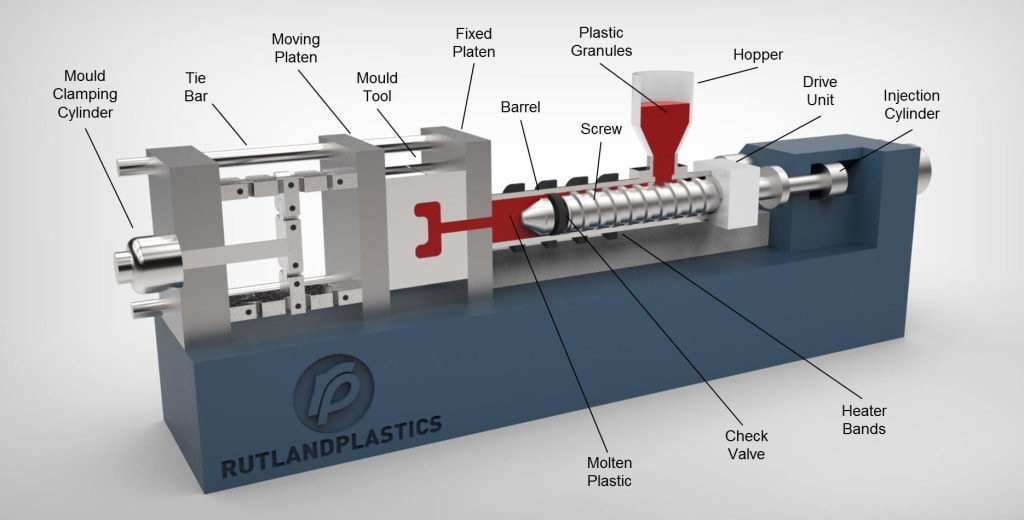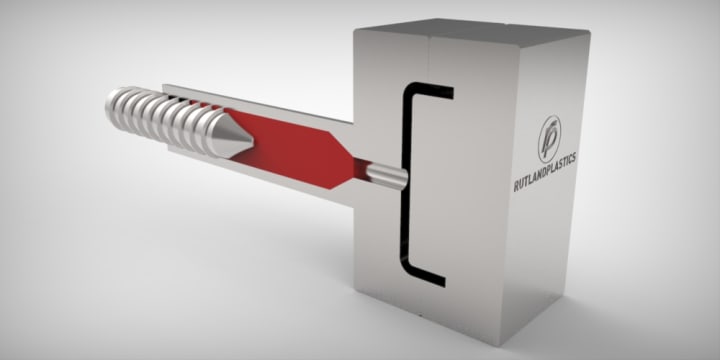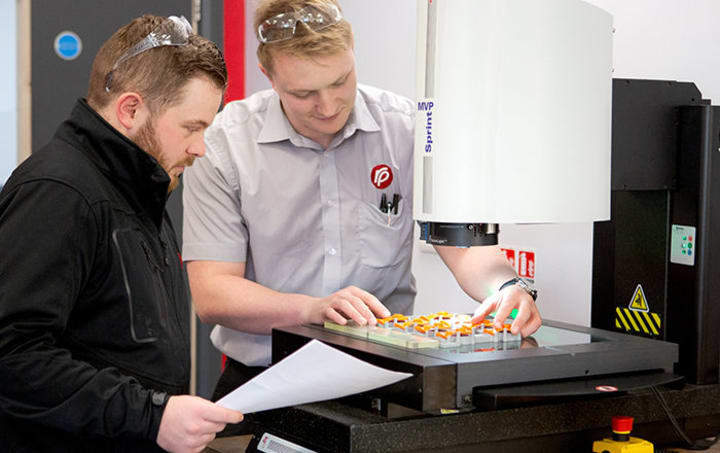A Step-by-Step Breakdown: How Injection Moulding Works
Unveiling the Process: A Detailed Guide to Injection Moulding

I. Introduction
Injection moulding is a highly versatile manufacturing process that plays a crucial role in the production of a wide range of plastic products. Understanding the step-by-step breakdown of how injection moulding works is essential for anyone involved in the manufacturing industry. Whether you're a design engineer, a production manager, or simply curious about the process behind everyday items, this article provides a comprehensive guide to demystify injection moulding.
II. What is Injection moulding?
Injection moulding is a widely used manufacturing process that involves the creation of three-dimensional plastic parts through the injection of molten material into a mould cavity. It is a highly efficient and cost-effective method for producing intricate and complex plastic components on a large scale.
In the injection moulding process, thermoplastic or thermosetting plastic materials are melted and injected into a specially designed mould. The mould consists of two halves, referred to as the cavity and the core, which form the shape of the final product. The mould is precisely engineered to ensure the desired dimensions and intricacies of the part being produced.
During the injection phase, the molten plastic material is injected under high pressure into the mould cavity through a nozzle. The material fills the cavity and takes on its shape, conforming to the contours and details of the mould. Once the material has solidified, the mould is opened, and the newly formed plastic part is ejected.
Injection moulding offers numerous advantages, including high production efficiency, consistent part quality, and the ability to create intricate designs and complex geometries. It is widely used in various industries, such as automotive, consumer goods, and medical devices, to manufacture a diverse range of products.
To ensure successful injection moulding, factors such as melt temperature, injection speed, and dwell time need to be carefully controlled. The selection of the appropriate plastic material and the design of the mould are also critical for achieving the desired results.
III. Key Components of Injection Moulding
Successful injection moulding relies on the integration and proper functioning of several key components. Each component plays a crucial role in ensuring the accuracy, efficiency, and quality of the final product. Let's take a closer look at the essential components involved in the injection moulding process:
A. Injection moulding Machine
The injection moulding machine is the workhorse of the injection moulding process. It consists of two main units: the clamping unit and the injection unit. The clamping unit securely holds the mould in place during the injection process, while the injection unit is responsible for melting and injecting the plastic material into the mould.
The clamping unit utilizes hydraulic or mechanical mechanisms to exert the necessary force to keep the mould closed during the injection process. It ensures that the mould remains tightly sealed and allows for the proper flow and distribution of the molten plastic material.
On the other hand, the injection unit comprises a screw, barrel, and hopper. The plastic material, typically in the form of pellets or granules, is fed into the hopper. The rotating screw conveys the material forward and melts it as it moves through the heated barrel. Once the plastic material reaches a molten state, it is ready for injection into the mould.
B. Mould
The mould is a crucial component of the injection moulding process, as it defines the shape and features of the final product. It consists of two halves: the cavity and the core. The cavity is the portion of the mould that forms the exterior surface of the part, while the core creates the internal features.
mould design is a critical aspect that involves careful consideration of factors such as part geometry, material flow, cooling channels, and ejection mechanism. The mould is precision-machined to ensure dimensional accuracy and to accommodate the shrinkage characteristics of the plastic material.
To facilitate the ejection of the moulded part, ejector pins are incorporated into the mould design. These pins apply force to eject the part from the mould once it has solidified. mould release agents may also be used to aid in the demoulding process and prevent the part from sticking to the mould surfaces.
C. Raw Materials
The raw materials used in injection moulding are primarily thermoplastic or thermosetting plastic resins. Thermoplastics are the most commonly used materials as they can be melted and solidified repeatedly without any significant degradation.
Thermoplastic resins, such as polypropylene (PP), polyethylene (PE), polystyrene (PS), and polyvinyl chloride (PVC), offer a wide range of properties, including strength, flexibility, and heat resistance. Thermosetting plastics, such as epoxy and phenolic resins, undergo a chemical curing process during moulding and exhibit superior heat resistance and dimensional stability.
Additives, such as colorants, fillers, and stabilizers, can be incorporated into the plastic material to enhance specific properties or improve the processing characteristics.
IV. Step-by-Step Breakdown of the Injection moulding Process

Injection moulding involves a series of carefully orchestrated steps to transform molten plastic material into a solid, three-dimensional product. Understanding each stage of the process is crucial for ensuring successful and efficient production. Let's explore the step-by-step breakdown of injection moulding:
A. Step 1: Clamping
The first step of the injection moulding process is clamping. The mould halves, consisting of the cavity and the core, are securely held together using the clamping unit of the injection moulding machine.
During this stage, the mould alignment and clamping force are critical for maintaining proper mould closure. The clamping unit applies tonnage, or force, to keep the mould halves tightly sealed. Hydraulic pressure is commonly used to achieve the necessary clamping force, ensuring that the molten plastic material does not leak during injection.
B. Step 2: Injection
Once the mould is securely clamped, the injection phase begins. The injection unit of the machine starts melting the plastic material and injecting it into the mould cavity.
The plastic material, in the form of pellets or granules, is fed into the hopper of the injection unit. Inside the heated barrel, the material is melted by the rotating screw, which generates heat and applies pressure. The melt temperature, injection speed, and dwell time are carefully controlled to achieve the desired melt consistency and ensure proper flow into the mould cavity.
C. Step 3: Cooling
After the mould cavity is filled with molten plastic, the cooling phase begins. Cooling is a crucial step that allows the material to solidify and take on the shape of the mould.
The mould contains cooling channels strategically positioned to extract heat from the plastic part. These channels help control the cooling rate and ensure uniform solidification. The cooling time varies depending on the part's complexity, size, and the chosen plastic material. Proper cooling is essential to achieve dimensional stability and prevent defects in the final product. Once the cooling process is complete, the part is ready for demoulding.
D. Step 4: Demoulding
Demoulding is the final step of the injection moulding process, where the solidified plastic part is ejected from the mould.
During demoulding, ejector pins located within the mould apply force to push the part out of the mould cavity. The use of release agents or mould release sprays can assist in smooth demoulding by reducing friction between the part and the mould surfaces. The demoulding process requires careful handling to prevent damage to the part or the mould.
V. Quality Control in Injection moulding

Maintaining high-quality standards is crucial in the injection moulding process to ensure the production of defect-free parts. Implementing effective quality control measures helps identify and address any issues that may arise during manufacturing. Let's explore the key aspects of quality control in injection moulding:
A. Dimensional Accuracy
One of the primary goals of quality control in injection moulding is to achieve dimensional accuracy in the produced parts. This involves ensuring that the final products adhere to the specified dimensions, tolerances, and design requirements. Dimensional accuracy is essential for proper assembly, functionality, and overall product performance.
To achieve dimensional accuracy, various factors are considered, including the design of the mould, control of process parameters, and proper cooling. Regular measurements and checks are performed using specialized tools and equipment to verify the dimensions of the moulded parts against the required specifications.
B. Defect Detection and Prevention
Quality control in injection moulding involves detecting and preventing defects in the produced parts. Defects can negatively impact the functionality, aesthetics, and overall quality of the product. Common defects include sink marks, warpage, voids, flash, and short shots.
To detect defects, visual inspections are carried out to identify any visible abnormalities or imperfections on the moulded parts. Non-destructive testing techniques, such as X-ray imaging or ultrasonic inspection, may be employed to detect internal defects that are not visible to the naked eye.
Preventing defects requires proactive measures throughout the entire injection moulding process. This includes optimizing process parameters, maintaining proper mould temperature, using high-quality raw materials, and ensuring consistent monitoring and adjustment of machine settings. By implementing robust process control and adhering to strict quality standards, the occurrence of defects can be minimized.
C. Inspection and Testing
Inspection and testing are integral components of quality control in injection moulding. It involves a comprehensive evaluation of the moulded parts to ensure they meet the required standards and specifications.
During inspection, various attributes of the parts are examined, such as surface finish, color, texture, and any other specific requirements defined by the customer. Specialized inspection tools, including coordinate measuring machines (CMMs), optical comparators, and gauges, may be used to measure critical dimensions and verify the conformance of the parts.
In addition to visual inspections, functional testing may be conducted to evaluate the performance and functionality of the moulded parts. This can include tests for mechanical strength, durability, chemical resistance, or any specific performance criteria relevant to the intended application.
By performing thorough inspections and testing, manufacturers can ensure that only high-quality parts that meet the desired specifications are released for further processing or assembly.
VI. Applications of Injection moulding
Injection moulding is a versatile manufacturing process that finds application in a wide range of industries and sectors. Its ability to produce complex parts with high precision and efficiency makes it a preferred choice for various applications. Let's explore some of the key areas where injection moulding is commonly utilized:
A. Automotive Industry
The automotive industry extensively relies on injection moulding for the production of various components. From interior parts like dashboards, door panels, and console trim to exterior parts like bumpers, grilles, and mirror housings, injection moulding enables the manufacturing of intricate and lightweight parts that meet the stringent requirements of the automotive sector. Injection moulding's efficiency and cost-effectiveness make it ideal for large-scale production in this industry.
B. Consumer Goods
Injection moulding plays a significant role in the manufacturing of consumer goods. It is widely used for producing items such as containers, packaging, caps, closures, and household products. The process allows for customization and the production of aesthetically appealing designs. Additionally, injection moulding facilitates the integration of features like inserts, hinges, and snap-fit mechanisms, enhancing the functionality of consumer goods.
C. Medical Devices
Injection moulding is vital in the production of medical devices and equipment. The medical industry demands high-quality and precise components with strict adherence to regulatory standards. Injection moulding enables the production of medical devices such as syringes, IV components, surgical instruments, diagnostic equipment, and various other disposable and reusable medical products. The ability to manufacture complex geometries and maintain sterility makes injection moulding a preferred choice in this field.
D. Electronics and Appliances
The electronics and appliance sectors benefit from injection moulding for the production of components like connectors, housings, switches, and buttons. Injection moulding enables the integration of intricate designs, precise dimensions, and functional features required for electronic devices and appliances. The process offers excellent repeatability and consistency, ensuring the uniformity of parts used in these industries.
E. Packaging Industry
Injection moulding is widely utilized in the packaging industry to manufacture containers, caps, closures, and other packaging components. The process provides the flexibility to produce items of various shapes, sizes, and materials, catering to diverse packaging requirements. Injection-moulded packaging offers advantages such as durability, product protection, and efficient stacking and storage.
These are just a few examples of the many applications of injection moulding. The process finds usage in several other industries, including aerospace, construction, telecommunications, and more.
VII. Advantages of Injection moulding
Injection moulding offers numerous advantages that make it a preferred choice for manufacturing complex parts. From cost-effectiveness to design flexibility, understanding the benefits of injection moulding is crucial in appreciating its value in various industries. Let's explore some of the key advantages of injection moulding:
A. High Production Efficiency
Injection moulding is known for its high production efficiency, making it suitable for large-scale manufacturing. The process allows for fast and continuous production, with cycle times typically ranging from a few seconds to a few minutes. The ability to produce multiple parts simultaneously using multi-cavity moulds further enhances production efficiency, resulting in higher output rates and cost-effectiveness.
B. Design Freedom and Complexity
One of the significant advantages of injection moulding is the design freedom it offers. The process enables the production of parts with complex geometries, intricate details, and precise features that would be challenging or impossible to achieve using other manufacturing methods. Injection moulding allows for the incorporation of undercuts, threads, thin walls, and overmoulding, expanding design possibilities and meeting diverse application requirements.
C. Material Versatility
Injection moulding accommodates a wide range of materials, including various thermoplastics and thermosetting plastics. This versatility allows manufacturers to choose materials with specific properties such as strength, flexibility, transparency, chemical resistance, and more. From commodity plastics like polypropylene and polyethylene to engineering plastics like ABS, PC, and nylon, injection moulding supports the use of different materials to suit the application's demands.
D. Cost-effectiveness
Injection moulding can offer significant cost advantages, especially for high-volume production. The ability to produce a large number of parts in a short period contributes to economies of scale, reducing the per-unit cost. Additionally, the high repeatability and minimal material waste associated with injection moulding further contribute to cost-effectiveness. The initial investment in tooling and moulds can be offset by the long-term savings achieved through efficient production and material utilization.
E. Part Consistency and Quality
Injection moulding provides excellent part-to-part consistency, ensuring uniformity in the produced components. The use of precise moulds, controlled process parameters, and automated systems contribute to the consistent replication of parts. Additionally, injection moulding offers excellent surface finish and detail resolution, resulting in high-quality parts that meet or exceed industry standards.
These advantages make injection moulding a widely adopted manufacturing process in various industries. However, it is essential to consider the limitations and challenges associated with injection moulding, which we will explore in the next section.
VIII. Limitations and Challenges of Injection Moulding
While injection moulding offers numerous advantages, it is important to consider the limitations and challenges associated with the process. Understanding these factors helps manufacturers make informed decisions and overcome potential obstacles. Let's explore some of the key limitations and challenges of injection moulding:
A. High Tooling Costs
One of the primary challenges of injection moulding is the high cost associated with tooling. The design and production of moulds require expertise and precision engineering, which can be expensive, especially for complex parts. The initial investment in moulds, including design, manufacturing, and maintenance, can pose a significant barrier, particularly for small-scale production or prototypes. However, for large-scale production, the amortized tooling cost can be offset by the cost savings achieved through efficient production.
B. Design Restrictions
Injection moulding imposes certain design restrictions that must be considered during the product development phase. Factors such as draft angles, wall thickness, undercuts, and part ejection need to be carefully evaluated to ensure mouldability. Design features that are difficult to mould or demould may require additional modifications or the use of specialized techniques like slides, lifters, or inserts, which can increase the complexity and cost of the tooling. It is crucial to collaborate closely with mould designers and manufacturers to optimize the design for injection moulding.
C. Material Selection and Compatibility
While injection moulding supports a wide range of materials, each material has its limitations and considerations. Certain materials may have specific processing requirements or limitations, such as temperature sensitivity, shrinkage, or warping tendencies. Compatibility between the selected material and the mould materials, including issues like mould corrosion or release agent compatibility, should also be taken into account. Careful material selection and testing are essential to ensure successful and consistent production.
D. Cycle Time and Production Rate
Although injection moulding offers high production efficiency, the cycle time required for cooling and solidification can vary depending on factors like part size, complexity, and material properties. Longer cycle times can limit the overall production rate and output capacity. Balancing cycle time with part quality and ensuring proper cooling to avoid defects or warpage is crucial. Advanced techniques like conformal cooling or process optimization can help mitigate cycle time challenges.
E. Environmental Considerations
Injection moulding involves the use of plastic materials, and the industry has been facing increasing scrutiny regarding environmental impact and sustainability. Addressing issues related to plastic waste, recycling, and the use of eco-friendly materials is crucial. Manufacturers should explore options like biodegradable or recycled materials and implement responsible waste management practices to mitigate the environmental concerns associated with injection moulding.
Understanding these limitations and challenges allows manufacturers to plan and strategize effectively, leveraging the advantages of injection moulding while mitigating potential drawbacks.
IX. Conclusion
Injection moulding is a highly efficient and versatile manufacturing process that has revolutionized the production of complex parts across various industries. Its ability to create intricate designs, maintain high production rates, and accommodate a wide range of materials makes it a preferred choice for manufacturers seeking cost-effective and reliable solutions.
Throughout this article, we have explored the step-by-step breakdown of how injection moulding works, from material preparation to mould filling and part ejection. We've also delved into the significance of quality control in ensuring the production of defect-free parts and the diverse applications of injection moulding in automotive, consumer goods, medical devices, electronics, appliances, and packaging industries.
The advantages of injection moulding, such as design freedom, material versatility, and cost-effectiveness, have been highlighted. However, it's essential to recognize the challenges, including high tooling costs, design restrictions, and environmental considerations.
Despite its limitations, injection moulding remains an indispensable manufacturing process, driving innovation and enabling the creation of products that shape our modern world. As technology continues to evolve and sustainability gains prominence, injection moulding will likely adapt, ensuring its continued relevance and contribution to the advancement of industries worldwide.
About the Creator
Rutland Plastics
Injection moulding is a fast & cost-effective way to produce high-quality plastic parts. Rutland Plastics has over 65 years of experience in injection moulding, making us the most trusted injection moulders in the UK. Visit us today!
Enjoyed the story? Support the Creator.
Subscribe for free to receive all their stories in your feed. You could also pledge your support or give them a one-off tip, letting them know you appreciate their work.






Comments
There are no comments for this story
Be the first to respond and start the conversation.